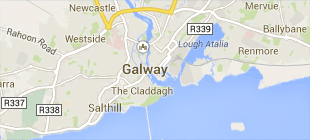-
Cúrsaí
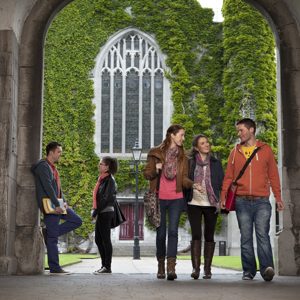
Cúrsaí
Tá roghnú cúrsa léinn ar cheann de na cinntí is tábhachtaí dá ndéanfaidh tú choíche! Féach na cúrsaí atá againn anseo agus an méid a deir mic léinn agus léachtóirí faoi na cúrsaí sin a bhfuil spéis agatsa iontu.
-
Saol na hOllscoile
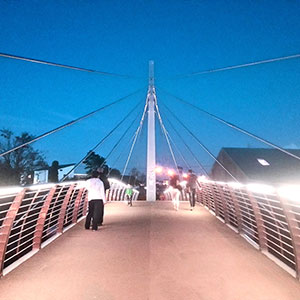
Saol na hOllscoile
Chuile bhliain roghnaíonn os cionn 4,000 duine Ollscoil na Gaillimhe mar chéad rogha. Faigh amach faoin saol in Ollscoil na Gaillimhe anseo.
-
Eolas Fúinn
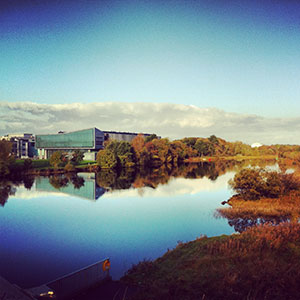
Eolas faoi Ollscoil na Gaillimhe
Bí ar an eolas faoin Ollscoil seo agus na fáthanna a bhfuil sí chomh speisialta sin – an stair thar a bheith spéisiúil a bhaineann leis an Ollscoil agus an nuacht is déanaí agus na hócáidí atá ar na bacáin.
-
Coláistí & Scoileanna
- Scoil na Tíreolaíochta, na Seandálaíochta agus Léann Éireannaigh
- Coláiste an Ghnó, an Bheartais Phoiblí & an Dlí
- Coláiste an Leighis, an Altranais & na nEolaíochtaí Sláinte
- Coláiste na hEolaíochta agus na hInnealtóireachta
- Scoil na dTeangacha, na Litríochtaí agus na gCultúr
- Roinn na Gaeilge
- An tAcadamh
- Stair
- Idirnáisiúnta
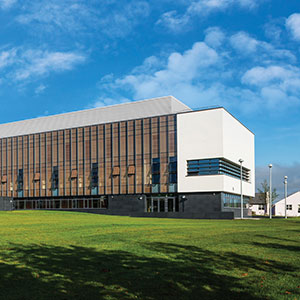
Coláistí & Scoileanna
Tá aitheantas idirnáisiúnta bainte amach ag Ollscoil na Gaillimhe mar ollscoil atá á treorú ag an taighde agus rún daingean aici teagasc den chéad scoth a chur ar fáil i réimsí éagsúla saineolais.
-
Taighde
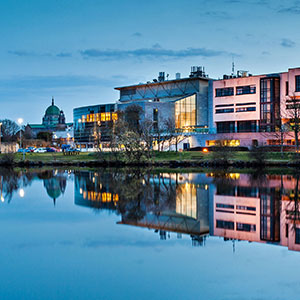
Nithe Fónta á gCruthú as Smaointe Úra
Tugann ár dtaighdeoirí aghaidh ar chuid de na dúshláin is práinní san 21ú Céad.
-
Gnó & Tionscal
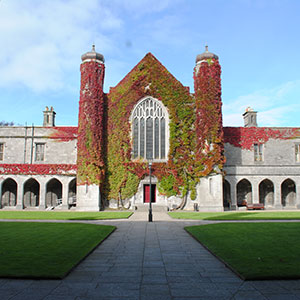
Tacaíocht do Thaighde Úrnua in Ollscoil na Gaillimhe
Déanaimid deiseanna tráchtála a chuardach agus a chothú don phobal taighde in Ollscoil na Gaillimhe, mar aon le comhpháirtíocht tionsclaíochta a chothú.
-
Alumni, Cairde & Lucht Tacaíochta
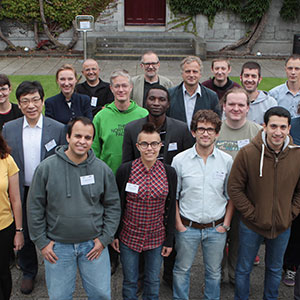
Alumni, Cairde & Lucht Tacaíochta
Tá os cionn 90,000 céimí de chuid Ollscoil na Gaillimhe ann ar fud an domhain. Déan nasc linn agus beidh teacht agat ar an gcomhphobal sin ar líne.
-
Rannpháirtíocht Pobail
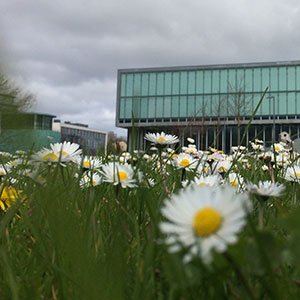
Rannpháirtíocht sa Phobal
In Ollscoil na Gaillimhe, creidimid go n-éireoidh níos fearr leat más féidir leat an méid a fhoghlaimíonn tú a chur i bhfeidhm i do shaol féin. Is mar gheall air sin go bhfuil béim mhór ar shocrúcháin oibre nó ar thionscadail phobail i gcuid mhór dár gcúrsaí.
Latest University News
8 December 2025
Na chéad trialacha ar domhan do leigheas nua ar phian ainsealach á gcur i gcrích in Éirinn
Fuair Cuibhreannas CrannMed Ltd., Salaso Health Solutions Ltd., Ollscoil na Gaillimhe agus Coláiste Ríoga na Máinleá in Éirinn maoiniú €6.5m tríd an gCiste Nuálaíochta Teicneolaíochtaí Suaiteacha
Tá cuibhreannas de chomhlachtaí teicneolaíochta leighis, cúraim sláinte digití agus taighdeoirí ollscoile ag seoladh sraith trialacha cliniciúla den chéad uair ar domhan, dírithe ar fhaoiseamh fadtéarmach a thabhairt do dhaoine atá ag fulaingt le pian ainsealach mhatánchnámharlaigh.
Bronnadh infheistíocht rialtais €6.5 milliún ar an gcomhpháirtíocht idir CrannMed, Salaso Health Solutions, an Institiúid do Thrialacha Cliniciúla in Ollscoil na Gaillimhe agus Coláiste Ríoga na Máinleá in Éirinn.
Tá an maoiniú, arna fhógairt ag an Aire Fiontar, Trádála agus Fostaíochta, Peter Burke T.D., mar chuid den tráinse is déanaí de dhámhachtainí ó Chiste Nuálaíochta Teicneolaíochtaí Suaiteacha.
Tá an tsraith trialacha cliniciúla á comhordú ag an Institiúid do Thrialacha Cliniciúla in Ollscoil na Gaillimhe agus ag Coláiste Ríoga na Máinleá in Éirinn.
Comhcheanglaíonn clár na dtrialacha dhá theicneolaíocht chomhlántacha chun torthaí a fheabhsú do dhaoine atá ag fulaingt le pian ainsealach mhatánchnámharlaigh. Beidh deis ag othair teacht ar chóireáil cheannródaíoch do phian atá forbartha ag CrannMed agus ar chlár téarnaimh atá forbartha ag Salaso le tacaíocht ó speisialtóirí cliniciúla.
Sa chéad triail, gheobhaidh othar instealladh a choisceann sreabhadh fola chuig suíomh na péine, rud a laghdóidh athlasadh agus néarchinn fhánacha, atá mar phríomhchúis leis an bpian.
Tar éis na cóireála tosaigh, déanfaidh an dara triail measúnú ar théarnamh an othair agus tacaíocht á fáil acu ó sheirbhís dhigiteach féinbhainistíochta bunaithe ar an Intleacht Shaorga. Bíonn ar othair, a bhfuil pian ainsealach orthu, tabhairt faoi phróiseas téarnaimh struchtúrtha le neart a fhorbairt agus le hathléimneacht fíochán matánchnámharlaigh a fheabhsú.
Ina theannta sin, cuirfidh na trialacha ar chumas eolaithe agus taighdeoirí sna hionaid chliniciúla teicnící nua íomháithe, dearaí trialacha cliste agus modheolaíochtaí tomhais
péine a fhorbairt a bheidh de dhíth chun an réiteach seo a dhéanamh caighdeánach laistigh de chórais cúraim sláinte.
Dúirt Liam Farrissey, Príomhfheidhmeannach CrannMed: “Is mór an sásamh dúinn a bheith in ann cuibhreannas ar chaighdeán chomh hard a chur le chéile anseo in Éirinn. Cuimsítear leis an gcuibhreannas réimse leathan scileanna – taighde agus forbairt na gcoincheap, déantúsaíocht, bailíochtú cliniciúil agus tacaíocht na hintleachta saorga d’fhéinbhainistíocht othar; agus tá an saineolas ar fad ag teacht ó fhoirne den scoth atá ag feidhmiú sa tír. Buntáiste iontach amháin a bhaineann leis seo is ea go mbeimid in ann ár gcóireáil a chur ar fáil d’othair Éireannacha i bhfad níos luaithe ná mar ab fhéidir murach sin. Má éiríonn linn, d’fhéadfadh sé bealach nua a leagan amach chun cóireáil a chur ar othair a bhfuil pian ainsealach orthu.”
Dúirt Aoife Ní Mhuirí, Salaso: “Tríd an intleacht shaorga a úsáid chun rannpháirtíocht a mhéadú le cláir féinbhainistíochta atá leagtha amach go cliniciúil, beidh torthaí níos fearr ag othair agus laghdófar an méid ama a bheidh ar dhochtúirí nó ar theiripeoirí maoirseacht a dhéanamh ar chúram iarghnáthaimh. Is féidir an cóireáil agus an téarnamh a dhéanamh níos gaire do bhaile, rud a shábhálann am agus airgead ar othair agus ar an gcóras sláinte. Tá an cur chuige níos inbhuanaithe, níos inrochtana d’othair, agus tá an cumas aige caighdeán domhanda nua a leagan amach maidir le bainistíocht péine.”
Dúirt an tOllamh Fidelma Dunne, Stiúrthóir na hInstitiúide do Thrialacha Cliniciúla in Ollscoil na Gaillimhe: “Tá sé i gceist ag an tionscadal seo réabhlóid a dhéanamh ar an gcaoi a gcuirtear cóireáil ar phian ainsealach sna hailt agus sna matáin. Cuirfidh an chóireáil nuálach agus an triail chliniciúil ar chumas othar faoiseamh éifeachtach, fadtéarmach a fháil ó phian ainsealach agus ní bheidh gá le máinliacht ná le drugaí andúile. Is sampla den chomhoibriú is fearr idir an earnáil acadúil agus tionsclaíochta é an tionscadal seo agus tá ríméad ar an Institiúid do Thrialacha Cliniciúla tacú leis na comhpháirtíochtaí seo trí shaineolas trialach cliniciúil a chur ar fáil.”
Dúirt an tOllamh Fergal O’Brien, Leas-Seansailéir Taighde agus Nuálaíochta in RCSI: “Tá bród ar RCSI tacú le teicneolaíocht leighis nuálach Éireannach leis na chéad trialacha cliniciúla ar dhaoine anseo in Éirinn. Léiríonn an chomhpháirtíocht seo go bhfáiltítear anseo in Éirinn roimh chomhoibriú i réimse an taighde chliniciúil, agus tá RCSI tiomanta do bheith ag obair le comhlachtaí Éireannacha chun réitigh shláinte nua a sholáthar d’othair.”
Dúirt an cuibhreannas go bhfuiltear ag súil go mbeidh na buntáistí a eascraíonn as an gcóireáil agus as na teicneolaíochtaí atá á dtriail deich n-uaire ar a laghad níos fearr ná instealltaí stéaróideacha, atá mar chaighdeán reatha cúraim i gcásanna péine ainsealaí matánchnámharlaigh.
Rinneadh an infheistíocht €6.5m faoi Ghairm 7 den Chiste Nuálaíochtaí Teicneolaíochtaí Suaiteacha (DTIF).
Críoch
8 December 2025
World-first trials for chronic pain pioneered in Ireland
Consortium of CrannMed Ltd., Salaso Health Solutions Ltd., University of Galway and RCSI University of Medicine and Health Sciences secure €6.6m funding through Disruptive Technologies Innovation Fund
A consortium of medtech and digital healthcare companies and university researchers are to launch a series of world-first clinical trials focused on bringing long term relief to people suffering from chronic musculoskeletal pain.
The partnership of CrannMed, Salaso Health Solutions, University of Galway’s Institute for Clinical Trials and RCSI University of Medicine and Health Sciences has been awarded €6.6million Government investment.
The funding, announced by Minister for Enterprise, Trade and Employment, Peter Burke T.D., is part of the latest tranche of awards from the Disruptive Technologies Innovation Fund.
The consortium will carry out the RECAP project - Resorbable Embolization for Chronic musculoskeletal Pain.
The series of clinical trials taking place as part of the project are being coordinated by University of Galway’s Institute for Clinical Trials and RCSI University of Medicine and Health Sciences.
The trial programme combines two complimentary technologies to improve outcomes for people with chronic musculoskeletal pain. Patients will have access to breakthrough pain treatment developed by CrannMed and a recovery programme developed by Salaso with the support of clinical specialists.
In the first trial, a patient will receive an injection which will selectively block blood flow to the site of pain, reducing inflammation and stray nerve endings, which are ultimately the root cause of the pain.
Patients who have experienced chronic pain need to pursue a structured recovery process aimed at building strength and improving the resilience of musculoskeletal tissues. The second trial assesses the patient’s recovery as they are supported by an AI enabled self-management platform in real-time.
Furthermore, the trials will allow scientists and researchers within the clinical centres to develop new imaging techniques, smart trial designs and pain measurement methodologies that will be needed to make the solution standard within healthcare systems.
Liam Farrissey, CrannMed Chief Executive Officer, said: “It is very rewarding to be able to put to put such a high quality consortium together from within the Irish eco-system. The consortium covers development, manufacture, clinical validation and AI enabled patient engagement all from within world class teams operating in the country. An exciting benefit is that we will be able to offer our treatment to Irish patients much earlier than would otherwise be possible. If we are successful, it can pave the way to change the way we treat chronic pain.”
Aoife Ní Mhuirí, Salaso, said: “Using AI to increase engagement with clinically prescribed self-management programmes will lead to improved patient outcomes while minimizing the time required from physicians or therapists to oversee post-procedure care. Treatment and recovery can happen closer to home, saving time and money for patients and the health system. The approach is more sustainable, more accessible for patients, and has the potential to set a new global standard for pain management.”
Professor Fidelma Dunne, Director of the Institute for Clinical Trials at University of Galway, said: "This project is set to revolutionize how chronic joint and muscle pain is treated. The innovative treatment and clinical trial will enable patients to get effective, long-term pain relief from chronic pain without surgery or addictive drugs. This project is an example of academic-industry collaboration at its best and the Institute for Clinical Trails is delighted to support these type of partnerships by providing clinical trial expertise to our industry innovators and ensuring accelerated access to innovative treatments for patients.”
Professor Fergal O’Brien, Deputy Vice Chancellor for Research and Innovation at RCSI, said: "RCSI is proud to support innovative Irish medtech through first-in-human clinical trials conducted here in Ireland. This collaboration shows that Ireland is open for business in clinical research, and RCSI is committed to working with Irish companies to deliver transformative health solutions for patients.”
University of Galway’s Institute for Clinical Trials has a pivotal role in the project, focused on clinical trial leadership, innovation in trial design and overall coordination and delivery of the clinical trial programme for the Disruptive Technologies Innovation Fund.
RCSI’s role in the project is to lead the development and validation of imaging and access protocols for direct injection of the CrannMed technology and conduct the first-in-human clinical use of the technology. Additionally, RCSI will contribute expertise in digital health to optimise patient engagement with the AI-enabled rehabilitation platform.
The consortium stated that the combined benefits of the treatment and technologies being trialled are expected to be tens of times better than steroid injections, which are the current standard of care for chronic musculoskeletal pain conditions.
The €6.5m investment was made under Call 7 of the Disruptive Technologies Innovation Fund.
Ends
8 December 2025
Sensory Friendly Santa’s Grotto brings Christmas magic to children and their families
More than 80 children with additional needs have enjoyed a unique opportunity to experience the magic of Christmas with a special visit to a Sensory Friendly Santa’s Grotto.
The two-day event on December 5th and 6th was facilitated by staff and students from the School of Psychology at University of Galway, who took on the important roles of elves and Santa’s helpers.
The annual Sensory Friendly Santa's Grotto has been a highlight of the year at University of Galway since 2017 and has grown to a weekend event, giving 48 families with additional needs the opportunity to visit Santa in a winter wonderland.
Children received individualised, sensory-friendly gifts from Santa and had their photos taken, creating special Christmas memories.
Dr Rachel Fitzpatrick, Dr Shauna Diffley, Dr Aoife McTiernan and Dr Helena Lydon from the School of Psychology coordinated the event, with a team of volunteer staff and students from the MSc in Applied Behaviour Analysis and final year students from the BSc Psychology programme at University of Galway.
Dr Aoife McTiernan, Director of the MSc and PhD in Applied Behaviour Analysis and Lecturer in Psychology, University of Galway, said: “Visiting Santa is a cherished Christmas tradition, but busy grottos filled with noise, bright lights, and queues can be challenging for children with additional needs. The Sensory Friendly Santa’s Grotto at the University of Galway offers a calm, magical experience designed especially for these children and their families, often giving them their first opportunity to meet Santa.”
Dr Rachel Fitzpatrick, Lecturer in Applied Behaviour Analysis, School of Psychology, University of Galway, said: “The event is made fully accessible and inclusive through small adjustments to the grotto and environment. Santa and the team connect with families in advance to help each child enjoy their visit at their own pace. It’s a true team effort, with Santa, the elves, and volunteers (staff and students from the School of Psychology) working hard behind the scenes to create real Christmas magic. We are deeply grateful to our generous sponsors across Galway and Ireland, and to the School of Psychology.”
The organisers also hope to spread Christmas cheer by creating a freely available "How to Guide” on running similar inclusive and accessible Santa's Grotto events. The aim is that it will encourage other businesses and organisations across Ireland to provide this unique opportunity for more families of children with additional needs to experience the magic of meeting Santa.
The event coordinators continued their annual tradition to collect for COPE's Christmas appeal with visitors and volunteers donating items for Christmas hampers for those in need.
Businesses from Galway and around Ireland sponsored the 2025 event and their generosity plays a critical role in making the magic of the event happen. Sponsors include Diligent, Liberty IT, Galway Camera Shop, Charlie Byrne’s Bookshop, 56 Central, Cregal Art, The Galmont, Connacht Hospitality Group, Irish Socksciety, Ground and Co, Smyths Toys Superstores, Supermac’s, The Galway Bay Hotel, Lidl and Home Store.
Business sponsor, Ruairí Conroy, Site Lead, Diligent Galway, said: “At Diligent, we’re committed to supporting initiatives that create meaningful impact in our community. The Sensory Friendly Santa experience is a truly special event, it ensures every child has the chance to enjoy the magic of Christmas in a way that feels comfortable and accessible. We’re proud to support the incredible work that goes into making this experience possible for families across Galway.”
Ends









